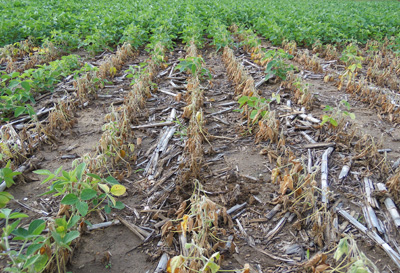Source: Michigan State University Extension
By Mike Staton
Frequent and heavy rains have created waterlogged and ponded areas in many soybean fields in Michigan. The excess soil water is detrimental to soybeans for several reasons and affected no-tillers need to know how to assess any yield reductions that may be associated with the flooded conditions. The following factors determine the level of yield loss:
- Duration of saturated soil conditions
- Daytime and nighttime temperatures
- Solar radiation
- Growth stage of soybeans
- Depth of water in relation to plants
- Moving water vs. ponded water
- Level of Phytophthora resistance or tolerance of soybean variety
Soybeans require oxygen to respire and produce energy and they obtain their oxygen from the soil. Because water contains very little oxygen, respiration and energy production is significantly reduced in waterlogged or saturated soils. In general, the longer the soil remains saturated, the greater the potential for yield losses.
Soil texture, soil structure and tile drainage all affect the duration of the waterlogged conditions. Temperatures above 80 F and sunny conditions also increase yield losses as they increase respiration rates and oxygen depletion. More rapid oxygen depletion occurs with larger plants and under ponded conditions.
If areas are waterlogged for 2 days, yield losses may be minimal. However, waterlogged conditions lasting for 4 days can cause significant yield reductions. Yield losses can range from 17-43% for plants in the vegetative growth stages. If the waterlogging continues for 6 days or more, plants will not recover and will die.
 Phytophthora root and stem rot on soybeans.
Phytophthora root and stem rot on soybeans.
Soilborne diseases may also infect surviving plants after the water recedes. Phytophthora root and stem rot is the most likely culprit because it is favored by wet soils and warm temperatures (Photo). There is nothing that can be done to protect plants from Phytophthora at this point in the season. However, varieties vary significantly in their resistance or tolerance to Phytophthora, so associated yield losses will also vary.
Saturated soils also reduce biological nitrogen (N) fixation and cause root nodules to die if the waterlogging persists for more than 6 days. This could lead to further yield losses due to a lack of N.
Growers should evaluate plants after the water recedes. Look for signs of new shoot growth from the main growing point and any of the existing leaf axils. If saturated conditions lasted for 6 days, dig up some roots and inspect the nodules. Healthy nodules should be firm and white or reddish-pink on the inside. If they are green, brown or mushy, they will no longer fix N and the plants may benefit from a supplemental N fertilizer application during the R1 to R2 growth stages. Information on identifying and responding to poor nodulation in soybeans is available online.






Post a comment
Report Abusive Comment